Archive for the 'Fruit' Category
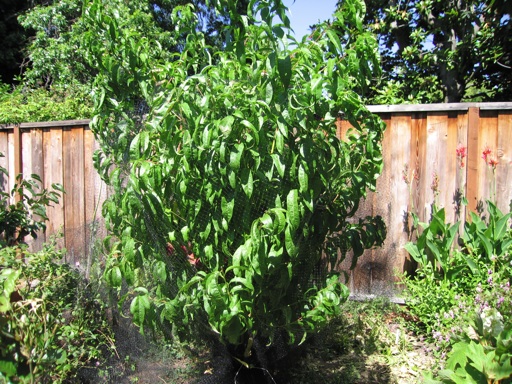
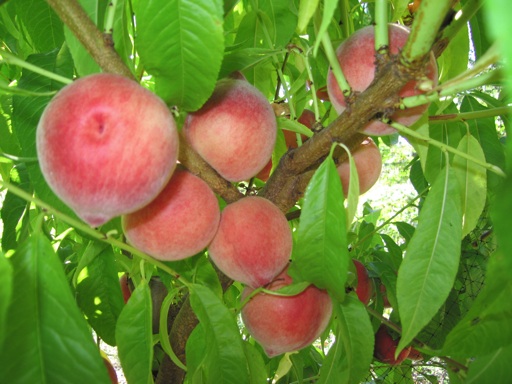
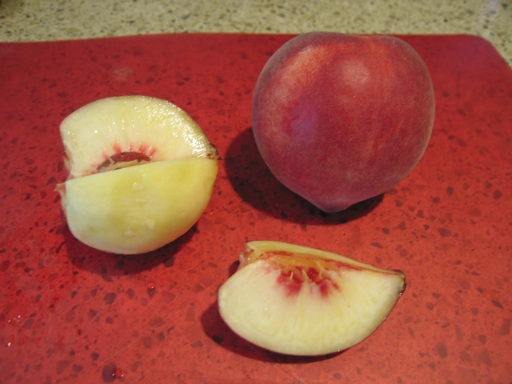
In the spring of 2009, I planted about a half dozen new fruit trees in our backyard. Two of the new trees were a Snow Beauty white peach and a Snow Queen white nectarine. This summer both trees have produced fruit for the first time. The first, second, and third photos above are pictures of the Snow Beauty tree, Snow Beauty peaches ripening on the tree, and the whole and sliced Snow Beauty fruit, respectively. All 3 pictures were taken in the past week and a half as the fruit has been ripening. Our Snow Beauty tree is a very vigorous grower. I have already heavily pruned the tree three times since I planted it last year. The first picture above was taken just after I pruned several branches off of the tree to make it easier to net.
Our Snow Beauty peach tree produced high quality fruit in its first year of production. The peaches have a nearly uniform creamy white texture with very few blemishes (see third picture). I would say that they have more flavor that the standard Babcock white peach. Most of our Snow Beauty peaches had a sweet-tart flavor. They are a only bit sweeter than a typical peach, although the larger sized fruit had a noticeably sweeter flavor than the smaller fruits. I really favor sweet peaches and nectarines, so hopefully, as the tree matures, the fruit will get sweeter.
Many of the Snow Beauty peaches were small, which I expected on such a young tree. But I was surprised that about 30% of the peaches from this tree were about as big as organic grocery store peaches. I pruned the tree heavily last winter, which limited its fruit production, and I think helped the peaches that the tree produced to grow to a larger size. The tree had about three dozen peaches this summer. Most of the fruit ripened in the past 2 weeks. 8 peaches are still on the tree, but those are nearly ripe. Overall, I am very happy with this tree.
Our Snow Beauty peaches tend to fall off the tree as soon as they are ripe. The bird netting I have on the tree really comes in handy here, because the peaches have been falling to a soft landing in the net rather than on the ground, where they are very likely to get bruised in the fall. So the netting is part of the reason that our Snow Beauty peaches have been nearly blemish free. I have noticed that the white peaches I have purchased from grocery stores often have several blemishes (e.g., bruised and discolored flesh).
Our Snow Queen nectarine hasn’t been as successful. It hasn’t grown anywhere near as much as our Snow Beauty peach, even though I have given both trees the same amount of water, fertilizer, and sun exposure. Our Snow Queen tree produced about a dozen nectarines this year, but nearly all of them split weeks before ripening. See the picture below. Many of the nectarines split right down to the pit. Many of the ones that didn’t split all the way to the pit were turning brown near the pit even though they didn’t feel overly ripe. Unfortunately, for these reasons, I only got to eat maybe 2 or 3 of the Snow Queen nectarines. However, the Snow Queen nectarines that I did eat were very sweet and had a great flavor, at least in my opinion. In general, I usually prefer the flavor of nectarines to the flavor of peaches.
I can see why the Snow Queen nectarine is popular in Southern California. It has a low chill requirement (200-300 hours), which makes it possible to grow and produce fruit there. The low chill requirement is not necessary where we live. We typically average about 700 chill hours here. I planted a Snow Queen tree, because I read the fruit is delicious. Now I am wondering if I can prevent the fruit from cracking open in the future. I have read that too much water can cause fruit split. I watered our Snow Queen tree nearly everyday this year, because it has not been growing much. Perhaps, I will cut back on the watering after it gets more established. All of rain we had in April and May may have also contributed to the splitting.
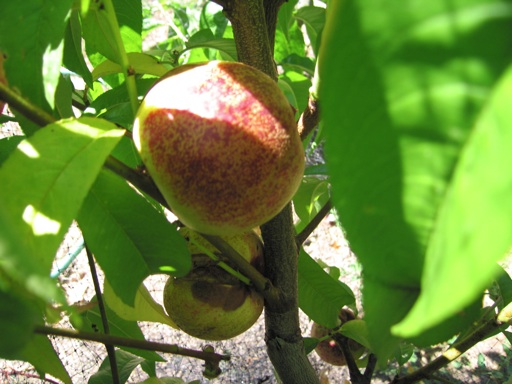
July 24 2010 | Peaches/Nectarines | Comments Off on White Peach v. White Nectarine
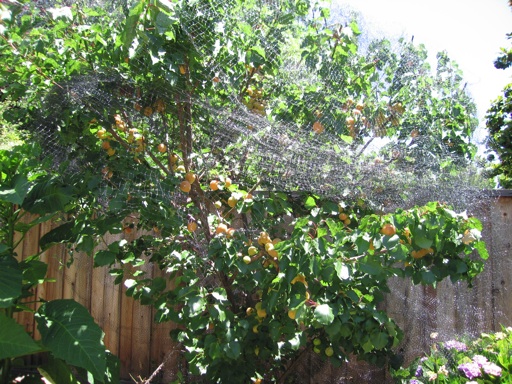
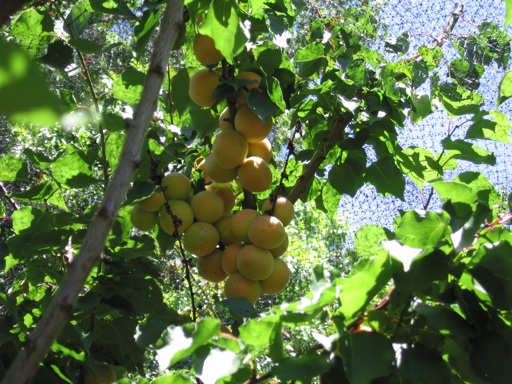
The 4th of July weekend is typically the time of year Blenheim apricots are at their peak of ripeness in our area. This year, my 8 year old Blenheim apricot tree had 200-300 apricots, which is an enormous amount of fruit compared to prior years. Last Monday, my mom and I spent the holiday picking the apricots and making apricot jam. Every year, I like to try making something new with apricots. This year, I decided to make apricot/orange conserve in addition to apricot jam. We made it by adding 2 cups of orange juice to an apricot jam recipe using oranges from my valencia orange bush. The apricot/orange conserve turned out to be especially good.
These pictures show my apricot tree a few days before we harvested the fruit. Fresh apricots are one of the things I look forward to with anticipation every summer. Like other types of stone fruits, they are in season for such a short time, but the flavor of home grown tree-ripened apricots makes them worth waiting for.
The bird netting I wrapped around the tree in mid-June kept the birds as well as the squirrels from harvesting the fruit before we did. Putting the netting on and taking the netting off is the most difficult part of growing and harvesting apricots in our yard. To make the process of netting the tree more manageable, I prune the tree heavily in the winter and once more in June just before putting the netting on to keep the tree about 10 feet tall. But besides the trouble of netting the tree, growing apricots is easy, at least in our climate. I fertilize the tree about once a year with all-purpose fertilizer and water it with an automatic drip system everyday in the summertime.
July 11 2010 | Apricots | Comments Off on Apricot Harvest
In March, we added two more raised beds in our backyard. We now have four raised beds that we are growing vegetables in. This year, we are growing tomatoes, potatoes, pole beans, peppers, eggplants, onions, basil, strawberries, cilantro, corn, zucchini, carrots, and cucumbers in our four raised beds. Although we haven’t harvested any vegetables yet, some of our vegetable plants are growing better than others.
Last October, I harvested seeds from dried up bean pods on our pole bean plants. I stored those seeds in a plastic bag over the winter and then planted the seeds in mid-March. Below is a picture of our pole beans today. In nearly 3 months, they have completely covered the fence I built for them last year.
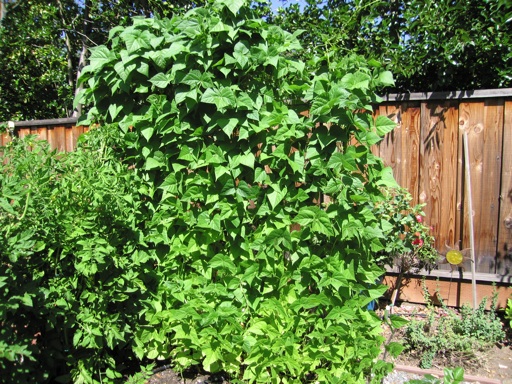
In my experience, pole beans have been really easy to grow by seed and very prolific producers. Nearly all of the seeds sprout without any stratification. And once the beans sprout, they grow quickly with minimal care and little or no fertilizer (at least in our soil which is amended with compost). Although snails and slugs will eat them if they are not protected somehow. Every year that we have grown pole beans (for about the past 4 years), they have produced more beans than we could eat.
Another plant we have had a lot of luck growing is tomatoes. We planted three tomato transplants (early girl, big beef, and champion) in March that we bought from a local nursery. They were about 4 inches tall at the time. They have grown very quickly over the past 3 months, even though the weather here has been much wetter and cooler than average. As shown in the next picture, they have already grown to completely fill their cages.

We also planted San Marzano tomatoes by seed indoors a few months ago. Growing tomatoes by seed is a first for us. Nearly, all of the tomato seeds sprouted, but as soon as I transplanted the first batch of seedlings outside in early May, they died. The remaining batches of tomato seedlings I “hardened off” by gradually exposing them to direct sunlight and the outside temperature a few hours a day. After hardening off for about 2 weeks, I planted the remainder of the seedlings outside in our new raised beds. The tomato seedlings I hardened off survived and are looking better, although they are only about 6 inches high now.
Of course, one of the advantages of growing plants by seed is access to a larger number of varieties, many of which are not easy to find as transplants. San Marzano tomatoes are supposed to be great sauce tomatoes. The next pictures shows the two new raised beds we just added in our yard. The San Marzano tomatoes are growing on the left side of the bed in the foreground.
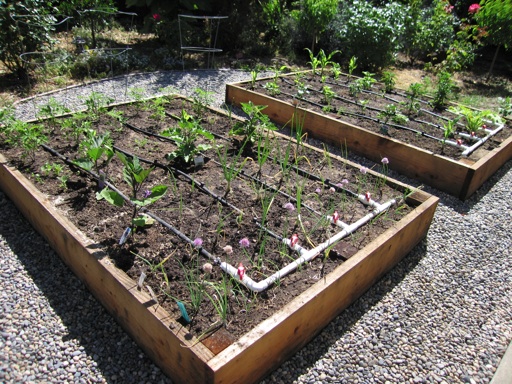
Some of the plants that we haven’t had much luck with this year are onions and leeks. I planted white onion sets, shallot sets, and leek transplants in one of our raised beds in March. The onions and leeks are growing on the right side of the bed in the foreground in the above picture. Although the onions and shallots sprouted, they haven’t grown much, and many of their leaves are turning yellow. The leeks haven’t grown at all since I planted them. I don’t have any idea why they haven’t grown well. But I tend to think that part of the fun of growing is taking a chance on growing new plants and that often means some of those plants don’t end up growing well.
Potatoes are another new plant we added to our garden this year. I planted yukon gold potatoes, which I ordered online as potato sets. I also planted white potato sets, which I purchased from a local nursery. The yukon gold potatoes look wonderful. They have already grown to about two feet tall and have really filled in the space around them (see picture below). The white potatoes sprouted, but they didn’t grow nearly as much as the yukon gold potatoes, so I ended up removing most of the white potatoes to make room for other plants.
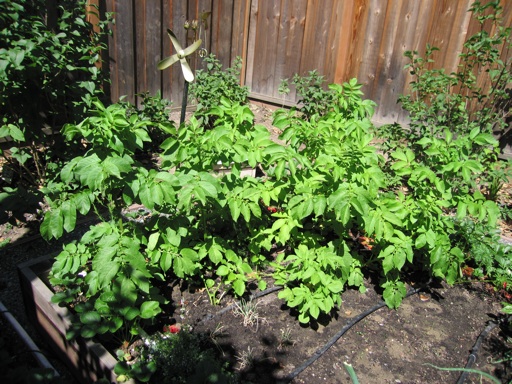
June 13 2010 | Beans and Onions and Potatoes and Tomatoes | Comments Off on Vegetable Garden Successes and Misses
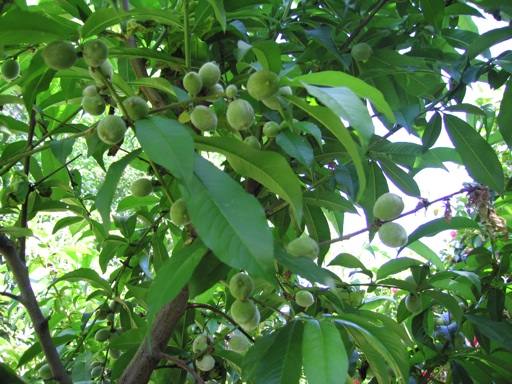
Today, I spent about an hour picking many of the newly forming peaches off of our 8-year old O’Henry peach tree. The tree probably set over 200 peaches. I think I picked about half of them off. Last year, I didn’t need to thin nearly as much, because I pruned the tree so heavily the previous winter, and the tree set about 40 large peaches that grew to grocery store size. This year, I didn’t prune nearly enough to prevent a heavy fruit set.
Two years ago, I didn’t thin much, and I waited too long to do it (in July). The tree ripened nearly 200 peaches that year, and they were small, only about half the size of grocery store peaches. Our tree isn’t large enough to ripen more than about 70 large peaches, so I plan on thinning again in a few weeks.
Peaches have a tendency to produce too much fruit. A large crop of peaches can cause the branches to sag and break off as the fruits get larger. Pruning and thinning greatly reduce the weight on the branches. Thinning and pruning also allow the tree to produce larger fruits. I’d rather have a smaller number of large peaches, than many small peaches. Although I realize that thinning is beneficial for these reasons, I still hate doing it. I feel like I am wasting good food.
Peaches form on the many small thin branches that grew during the previous year. Most of these branches can only support a few peaches. Today, I thinned to about 1-3 peaches per branch, trying to space them apart by at least 4-6 inches, per advice I read in different gardening publications. The photo above was taken before I started thinning.
I have learned through experience that thinning needs to be done early in the season, and mid-spring is the time to do it. When I waited until summer to thin in 2008 about 5 weeks before harvest, the peaches I left on the tree after thinning did not grow any larger. Although thinning always reduces the load on sagging branches.
May 02 2010 | Peaches/Nectarines | Comments Off on Thinning Peaches
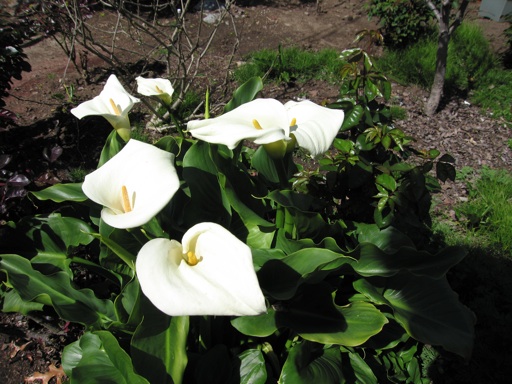
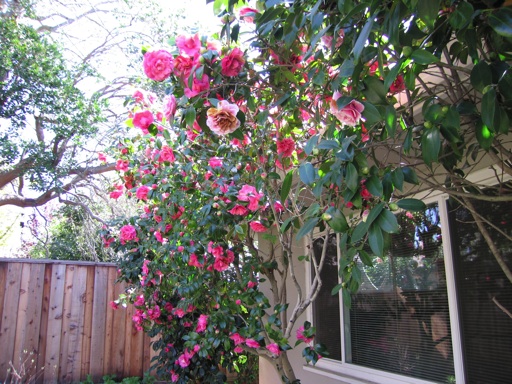
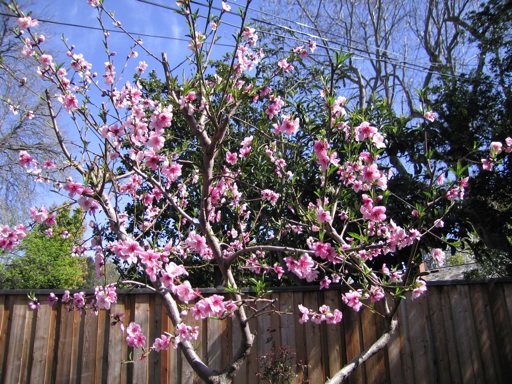
The vernal equinox occurred this morning at 10:32 am PDT, but spring flowers have been blooming in our yard for several weeks now. The first picture shows some of the many white calla lilies that are blooming in our backyard this month. After planting them all over our backyard for years, I started to remove many of them last year, because they are a favorite hiding place for snails. Despite my attempts to reduce their numbers, the remaining calla bulbs have multiplied and are as numerous as ever. Callas seem to thrive on lots of water, and the plentiful rainfall we received this winter has caused them to grow and flower prolifically in the past few weeks.
The second picture shows three pink camelia bushes that are blooming in our backyard. These camelia bushes, which are very established and probably decades old, produce an abundance of flowers every winter and spring without requiring much care. They are among my favorite of the plants in our backyard. However, they do make a big mess when they drop their numerous flowers on the ground.
The third picture shows our O’Henry peach tree in bloom. We have four peach and nectarine trees, and all of them produce pink flowers. Our peaches and nectarines (and almond tree) are the only fruit trees we are growing that have pink flowers. The rest of our fruit trees (apricot, plum, cherry, apple, orange, and pear) have white blossoms. The O’Henry blossoms are particularly long lasting. This tree has been covered with blossoms for over two weeks now.
March 20 2010 | Camellias and Flowers and Peaches/Nectarines | Comments Off on Spring Blooms
« Prev - Next »













